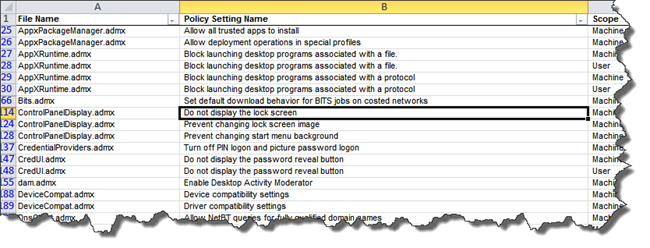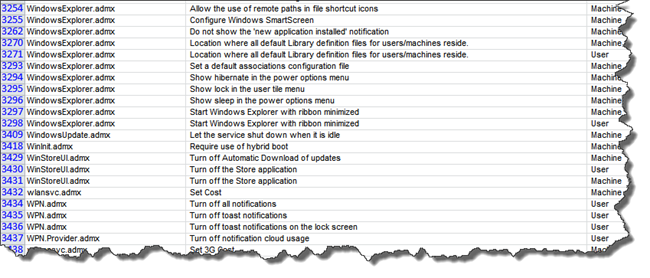Seeing the [Corp] magic behind the [Win8] scenes... "Group Policy Settings Reference for Windows and Windows Server"
Microsoft Downloads - Group Policy Settings Reference for Windows and Windows Server
"These spreadsheets list the policy settings for computer and user configurations included in the Administrative template files delivered with the Windows operating systems specified. You can configure these policy settings when you edit Group Policy objects (GPOs).
Version:April 12, 2012
Date published:4/13/ 2012Language:English
WindowsServer2003SP2GroupPolicySettings.xls
WindowsServer2008andWindowsVistaSP1GroupPolicySettings.xlsx
WindowsServer2008R2andWindows7GroupPolicySettings.xlsx
WindowsServer8BetaandWindows8ConsumerPreviewGroupPolicySettings.xlsx
WindowsVistaGroupPolicySettings.xlsUsing column filters, you can filter the information in these spreadsheets by operating system, component, or computer or user configuration. You can also search for information by using text or keywords.
These spreadsheets include the following categories of security policy settings: Account Policies (Password Policy, Account Lockout Policy, and Kerberos Policy), Local Policies (Audit Policy, User Rights Assignment, and Security Options), Event Log, Restricted Groups, System Services, Registry, and File System policy settings. These spreadsheets do not include security settings that exist outside of the Security Settings extension (scecli.dll), such as Wireless Network extension, Public Key Policies, or Software Restriction Policies.
- Group Policy Settings Reference for Windows Server "8" Beta and Windows "8" Consumer Preview: This spreadsheet lists the policy settings for computer and user configurations included in the Administrative template files (admx/adml) delivered with Windows Server® "8" Beta. The policy settings included in this spreadsheet cover Windows "8" Consumer Preview, Windows Server "8" Beta, Windows 7, Windows Server 2008 R2, Windows Server 2008, Windows Vista with SP1, Microsoft Windows Server 2003 with SP2 or earlier service packs, Windows XP Professional with SP2 or earlier service packs, and Windows 2000 with SP5 or earlier service packs. These files are used to expose policy settings when you edit Group Policy objects (GPOs) using the Group Policy Management Console (GPMC).
You can use the filtering capabilities included in this spreadsheet to view a specific subset of data based on one value or a combination of values that are available in one or more of the columns. In addition, you can click Custom in the drop-down list of any of the column headings to add additional filtering criteria within that column. To view a specific subset of data, click the drop-down arrow in the column heading of cells that contain the value or combination of values on which you want to filter, and then click the desired value in the drop-down list. For example, to view a subset of policy settings that are available for Windows Server 8 Beta in the Administrative Template worksheet, click the drop-down arrow next to Supported On, and then click At least Microsoft Windows Server 8 Beta.
What's New for Windows Server "8" Beta and Windows "8" Consumer Preview?
The spreadsheet contains three columns that provide more information about each policy setting's behavior related to reboots, logoffs, and schema extensions. These columns are the following:
- Reboot Required: A "Yes" in this column means Windows requires a restart before it applies the described policy setting.
- Logoff Required: A "Yes" in this column means Windows requires the user to log off and log on again before it applies the described policy setting.
- Active Directory Schema or Domain Requirements: A "Yes" in this column means you extend your Active Directory Schema before deploying this policy setting.
..."
This is some interesting reading if you want to see what kind of settings and controls businesses, and yourself, will have in Windows 8.
Here's an example, filtered for Windows 8, Consumer Preview.
For example, want to change how Win8 Windows Explorer Ribbon looks, expanded or minimized? There's a setting for that...
And the beauty of this all is that all of these are just registry entries. So if you know where to poke, you can write apps to do it too (as opposed to using the Group Policy Editor and walking people through all of that...)








No comments:
Post a Comment